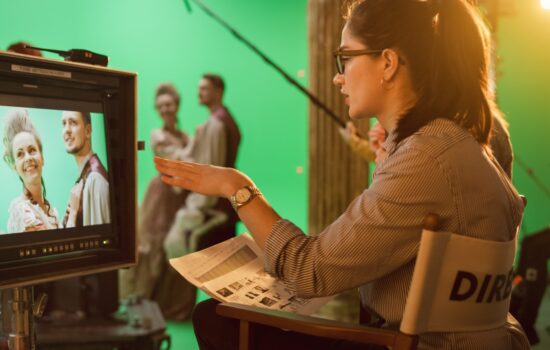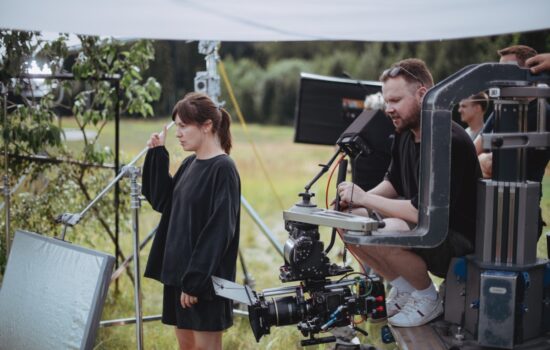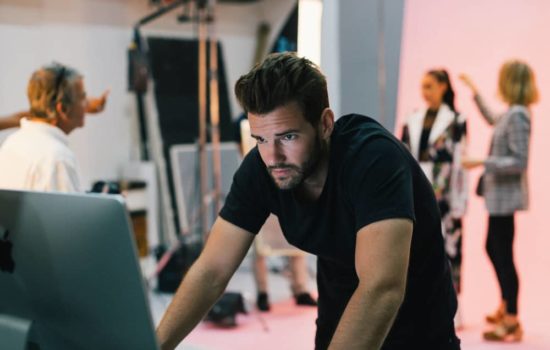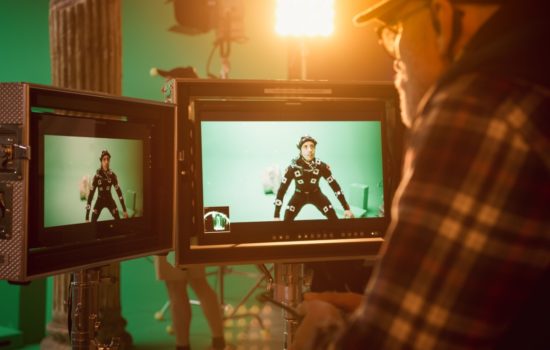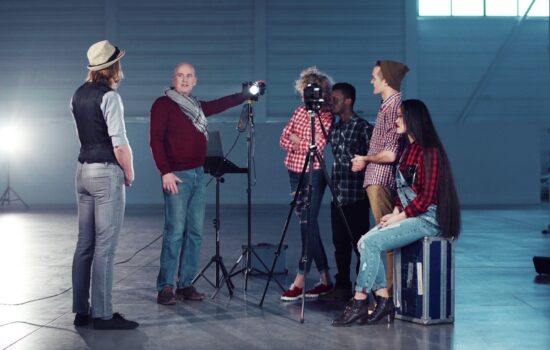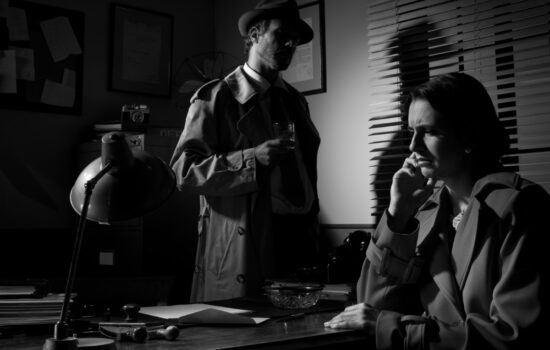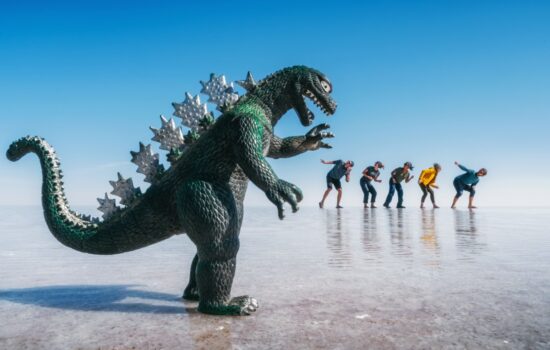Grip
Career Overview
Grips are part of the Grip Department. The Key Grip hires and oversees the Best Boys, Dolly Grips, Hammers and Rigging crew for a production. They make sure sets and rigs are safely built and maintained, collaborate with the Gaffer on lighting and, after the 1st AD, ensure safety on set.
Alternate Titles
First Company Grip
Avg. Salary
$59,0001
Salary Range
$41K-$131K1

How To Become a Grip
People also ask
Career Description
Les Tomita, Key Grip on blockbuster features such as Jurassic World, Furious 7, Godzilla: King of the Monsters and The Hunger Games: Mockingjay Part 2, starts off by saying that most people don’t really know what Grips do, not even Grips themselves!
In his quest to explain the intricacies of the job, he starts by explaining the origin of the word “grip”: “It comes from an English word — a ‘grip’ was a leather satchel that carried tools, a bag. Way back in the day, people would say, ‘Hey, grab your grip and grab your best boy and come do this job.’
So a Grip was a kind of ‘handy man,’ if you will. That’s not necessarily what it is today, but that’s how the department came to be.”
Tomita explains that there are only three departments in all of production that exist to be in service to every other department: Production, Transportation, and Grip.
He illustrates: “Of all the equipment and responsibilities that a Grip has, if you look at their equipment, they have 40’, ten-ton trucks, and not one piece of that equipment is specifically for a Grip. It’s support equipment. It’s for lighting, camera, construction, stunts, production, etc.
“Grips support the whole company and our tools cover the entire craft of filmmaking. This is why Grips don’t necessarily know the extent of what the department does.”
By way of explanation, Tomita divides a Grip’s job into two aspects: there are off-production Grip responsibilities, and on-production Grip responsibilities. He goes on: “If you have spent your entire career on one side of the Grip Department, you don’t really know what the other does.”
To start, Tomita focuses on the on-production side of things: “On the production side, Grip does anything to do with camera movement. Moving apparatus, positioning a rig or a car-mount, anything camera-related is a Grip’s responsibility.
Within production, we have the Key Grip, and I am essentially the manager, the department head. Then you have the Best Boy, who also works as an Electrician’s Best Boy — they are responsible for people and equipment. They have an enormous amount of responsibility and it is the hardest, most unappreciated job there is.
“My job as Key Grip is just to stand next to the Director and the Cinematographer and say, ‘I need,’ ‘I want,’ ‘I have to have.’ And I delegate to my Best Boy. They are the ones who have to pull it all together. That position is so underrated and most people have no idea what they do.
“It’s easy for me to ask for things, but it’s much harder for them to put it together. The Best Boy becomes the nucleus, liaising with whatever department we’re supporting. They’re unsung heroes.”
The other key aspect of gripping on the production side is lighting. When setting up a shot, the Cinematographer brings over the Key Grip and the Gaffer after choreographing and blocking the scene with the Director.
This workflow prompts Tomita to dig down into the meat of lighting: “Grips shape light, and we diffuse light. There’s always the argument about who lights the set; if you ask the Gaffer, they will claim the throne, but ask an experienced Key Grip and they will say it’s a collaborative effort. If you think about the physics of it, not only does the Grip have to rig the lights wherever they may be, the Electrician has to power the lights.
“The Gaffer might come in and say, ‘I need a light there, I need a light here and I need a soft fill here.’ But these lights are uncontrolled at the beginning — they need lots of shaping and texturing. The Grip department actually does that shaping by diffusing, bouncing, and changing the quality and temperature of the light.
“Not only that, but the Grip Department controls where the light is (and where it is not) supposed to be. That is the truth. A humble Gaffer knows that lighting is a collaborative effort.”
Tomita goes on to highlight another of the Grip’s responsibilities — building the tents or overheads in order to control sun. He says, “Mother Nature doesn’t wait for us to shoot a two-minute scene in thirteen hours, so we custom-build day-for-night locations so we can shoot night scenes during daylight hours.” This brings Tomita to the second major aspect of the Grip Department that a Key Grip needs to manage: rigging.
“We fly very large panels of blue or green screen these days for after effects. Those are my responsibility. The rigging is as important, if not more important than the production aspect. Those people are pre-rigging and pre-setting everything prior to the production company coming in. And the Riggers get no glory because they are handling the heavy lifting before the shoot; the studio people and the Actors, etc. don’t see them under their specific, production day microscope.”
Tomita explains that rigging might take an hour, or it might take three weeks to pre-rig and build a set. Interestingly, he describes Rigging Grips as having a combination of construction and engineering mindsets: “If we are flying an overhead off a construction crane, they need to know the physics of wind velocity, size, scale, the whole nine yards. They need to ensure that when we are in production, nothing fails. If it fails, it could kill someone.”
The skill and bravery involved in rigging are incredible, says Tomita: “We are building huge blue screens in areas like Atlanta where there are flash floods, high winds, and storms that pop up within minutes. We have to build these structures outside without them blowing over.
“Rigging Grips precede production and we work very closely with the Construction and Set Building Departments, building tracking for blue and green screens, bounces, night backing, and trans lights, etc. Grips rig the chain motors and the trussing. Honestly, we have a huge amount of responsibility and the skillsets needed for on and off-production Grips are vastly different.”
Tomita address the specifics of the workflow for a Key Grip: “We might come in very early in pre-production to prepare. When a Key Grip accepts a job, we come in about six weeks earlier than anyone else. It’s myself, my Rigging Key (or Key Rigger), and our Best Boys.
“During that pre-photography prep period, we plan and engineer and do all the technical scouting to see what the project entails. We’ll have read the script and we work very closely with Construction, Production Design, and Visual Effects Departments. It all works in concert; let’s say, for example, you build a big set without the involvement of Grip and Lighting.
“You could lose hundreds of thousands of dollars because we might have to come in post facto to modify it. There might be explosions or big stunts, ceilings might need to fly and parts of the set might have to move in order to accommodate the Stunt Department ratcheting people through.
If we’re shooting it on stage, we’re rigging huge blue or green screen panels for the Visual Effects Department so it’s much more effective to bring the Keys in in pre-production and we can work together.
“What if we build lighting into a stage and then the Stunt People come in and say they can’t pull off their work because there are lights in the way? That’s no use!”
It turns out that when it comes to safety on set, after the 1st AD, the Key Grip is responsible. Says Tomita, “Nobody knows that. And oddly enough, in my thirty-eight years in this industry, nobody has ever asked me for a degree or a certificate that qualifies me to be the second in charge of safety on set! It’s crazy! It’s just an evolutionary position.”
Tomita illustrates some of the safety challenges he faces on a day-to-basis on his current job on Magnum P.I.: “We use electric vehicles a lot now, including motorcycles. They’re fast, they’re quiet and we can rig cameras on them. Recently on Magnum, I rigged an electric motorcycle that has the capacity to go 90 m.p.h. Those cameras have to be rigged safely so the rider can do what they have to do without killing themselves. That’s a real skill.”
What is the Grip in film?
A Grip is a person who works on a film set and is part of the team that works with the equipment needed for the proper set up of the camera and lighting for a film.
Why are Film Grips called Grips?
The origin of the title Grip is generally recognized as coming from the handbag that individuals in this position would carry that contained the tools they would use on a film set.
Salary
The mid-range salary for a Key Grip is approximately $59,000. The salary range for Key Grips runs from $41,000 to $131,000.
Earnings for Key Grips vary wildly depending on your yearly output and employment time. Nonetheless, Tomita suggests that day-playing, infrequent Keys can make around $100,000 over the course of a year, while the in-demand Keys working on the huge studio movies are earning well north of $500,000 and beyond. For entry-level gigs, check the Local 80 site for current minimum rates (see below).
How much do Film Grips get paid?
How much a Film Grip is paid depends on several factors, including their union status, their specific title, and the number of jobs they book in a given year. Individuals who have risen to the position of Best Boy Grip or Key Grip may earn anywhere from $50,000 to $100,000 annually.
Hey, what do you think about trying our new Film Career HelperFilm Career Helper really quick? It’s totally free and could help get your career moving fast! Give it a try. It’s totally free and you have nothing to lose.
Career Outlook
It’s a catch-22, says Tomita: “If you want a work/life balance, do not consider becoming a department head. Unless you develop a rare crew that can cover your position, you cannot take time out for your life. In order to develop your career and get to that point where you pick and choose what you do, much of your career is having to do what you’re offered (even if it’s six months of straight nights in mid-winter in Alaska).”
Nonetheless, there is balance to be found if you want to stop short of becoming a Key Grip. Tomita clarifies: “The reality is, you can work 365 days a year being a solid Set Grip. Most people are trying to progress to the next step, but you can actually make a darn good living just being a good Set Grip.”
The other art form in Tomita’s department is a Dolly Grip. Tomita shares his thoughts about Dollying: “If you possess those skills, you can work every single day of the year because that art is being lost. With things like Ronin heads, Movis, hand-held stabilized cameras, and prosumer equipment, the current generation is losing the skill of being a Dolly Grip. It’s an art, and it’s hard, so much harder than operating.”
Tomita also explains that as a Rigging Grip, if you’re missing for a day, no one really notices. But if you’re on the production side, you cannot disappear for a day — it gets noticed. And as a department head, you simply cannot be missing. You have to be there to execute. So if you have family to attend to, it just can’t happen if you’re needed on set. We spend so much more time in production than we do with our families.”
What is a Grip vs. Gaffer?
A Gaffer is a Film Electrician. They work directly with the electrical cabling and other equipment needed for a movie. A Grip is a technician who works with all complementary equipment, such as tripods, dollies, or cranes, that are often needed as well for a shot or scene in a film.
Career Path
Tomita is currently in Hawaii doing Season 2 of Magnum P.I. and, despite his vast experience in the industry, this is his first TV gig: “This is the first television I’ve done in my career. I’ve done features the entire time, including 85% of Michael Bay’s films. So this is an adventure for me, a learning curve. It’s still filmmaking, but it’s a different, faster, schedule-oriented process.”
Looking back on his career, Tomita laments the lack of cross-production experience Grips get these days: “We used to have a card system back in the day. We had to become a studio employee, a studio Grip, and you could not even touch production until you had at least five to seven years of tenure as a studio Grip in the construction and rigging end of the department.
“I started my career on the original Five-O in Hawaii, then I moved to California to join the Stunt Department. The Grip Department helped us a lot with the rigging and, in my downtime between stunt gigs, someone gave me the opportunity to come in and rig. That’s how I entered the Grip Department. I had come from the production side and understood what was involved from that perspective.
“That would be so useful these days, for Grips to experience what it’s like to rig and take on huge builds, as well as get some insight into the production aspect.”
Now that Tomita is a Key Grip, he is settled at the pinnacle of his career and is delighted to have come full circle: “I decided to come home; I’d been doing a lot of traveling, following the tax incentives to places like New Orleans and Atlanta in the last seven years. I’ve spent most of my time in Atlanta, not in L.A.
“I promised my family that when they needed more assistance, I’d come back home and be close. And now I can do that and still work. I’m fortunate.”
“The advice I give people trying to get into the industry is to become a PA. The benefit is that you get to watch and learn the process of what everyone does. Then you can make an educated decision and say, ‘I’d really like to get involved in camera’ or ‘I love electric and lighting or the Grip Department.’ The interesting thing about our industry is that most people don’t really know what people in other departments do. As a PA, you get to see every aspect.”
On an imminently practical level, aside from becoming a PA, the union is the place to start. You need to rack up thirty days of experience to join, and Tomita says they call these people ‘30 day wonders’: “You put in 30 permitted calendar days within a 365 day period and you become a qualified member of the Local 80 Union. The rule is that as long as the Local membership is exhausted, you can hire from outside the union roster.
“That’s when we move on to permit days and hire from the outside. It can be so busy that there are no qualified, available technicians and they bring in permit hires. It’s not the easiest thing to do, but it is doable. Put your name on a list at the union and see if they call.”
There’s more encouraging news for aspiring Grips: “You can actually go directly to the studio itself, whether it be Sony, Colombia, Universal, CBS, Warner Brothers; they have their own Grip and Electric Departments. You can go in and put your name on something called a ‘call board’ and say you’re available to put in any time or days should they need permits.
“The studio is a valuable source. Be on call, do your due diligence and keep your name on those lists. When the town is busy, it’s a good opportunity to be brought in to work.”
- Try and get a PA gig on any production. That way you’ll get insight into all the roles in the Grip Department and beyond.
- Get your name on the permit list at the union and at the major studios. Make sure your number is on their sheet and start building your thirty days.
Experience & Skills
When people think of the film industry, they often think of cameras and Actors, but the industry itself is different from any other; everyone has a particular skill set for it. Tomita expands on this idea: “If you’re computer-savvy, there’s graphics and set design.
If you are construction-minded, there is set building and construction. We have lighting, digital imagery, playback . . .endless sources of jobs in our industry. Anyone has the opportunity to work here, and the Grip Department offers a lot of potential variety.”
Tomita has one piece of advice for aspiring members of his industry: “Make your career choice with your eyes wide open. Take that choice calmly and carefully — don’t rush. If you can get in as an entry-level PA, you’ll get to watch the whole industry with some perspective and understand which department gels best with your own skillset.”
As a young adult, Tomita loved photography, construction, fixing and building things: “I was the perfect combination for a Grip. I had all of these elements and skills and the Grip Department became my natural home.”
Not only that, but Tomita was a mathematician in a certain sense: “I looked at the numbers and I recommend you do the math, too: everyone wants to work on the camera, or direct, or pull focus. No one really sets out to become a Grip.
“When you get into the industry, people overlook the numbers; in the Grip Department on the production side, we have the Key Grip, a Best Boy, two Dolly Grips, maybe five extra Hammers. On the rigging side, numbers can vary from between five and fifty in a given day. There’s only one Director, only one Cinematographer, one First AD, one First AC, maybe a couple of Operators.
“When you start looking at it, pay attention to the numbers. The competition when there’s only one role in a show vs. twenty or thirty possible roles in Grip or Electric or Effects, it becomes clear where the work is!”
Tomita leaves one last gem for anyone considering sharpening their skills to become a Grip: “The thing that most people don’t really know until they become a Grip is that they cannot be afraid of heights! It’s just part of the breaking in period. And you have to be physically fit because it’s a lot of manual labor.
“You should also have some form of construction knowledge. As far as the production side goes, the artistic aspect, that can be taught. But the engineering skills are so specific, so brush up on those!”
The pressure of production means that a Production Grip has to have the right temperament to be able to react and work without panicking.
As Tomita illustrates, “They are always the last department to do their job before camera rolls. It’s about adjusting cameras, adjusting lights, tweaking, dimming, panning, right at the last minute. It’s the Grips on those ladders making final adjustments before they’re ready to go.
“We have to be able to work under intense pressure so, in terms of personality, you need the ability to focus and be the last person to be screamed and yelled at, but still to work methodically and safely. There are a lot of people that don’t have that in them. It’s about composure, handling yourself in a professional manner.”
When it comes to the other side of gripping, the Rigging Department, the pressure is different: “Rigging Grips don’t have that microscope on them so it’s not as intense. Saying that, I normally have a couple of my Rigging Grips with me on set, the very ones that built the setup, so that if anything goes wrong, whether it be technical, chain motors or whatever, they can go and resolve the issues.
“Production Grips, on the whole, have forgotten how to rig. If something goes wrong with a controller box or a feed, it takes them way too long to source the problem. The Riggers know what to do immediately and I know how long it’s going to take them to resolve it. Production hates having extra people and equipment on set, but it saves a lot of time in the long run.”
How do you become a Film Grip?
Becoming a working Film Grip means accumulating a variety of skills that would make you valuable on a film set. This includes knowledge of cameras, lighting equipment, general electrics and wiring, carpentry, and construction. But beyond those skillsets, it’s imperative that aspiring Film Grips network and forge connections with others in the industry to help find jobs and be considered for future gigs.
Education & Training
Tomita points to his union (Local 80 in Los Angeles) for classes and training: “You can go to the union and sign up for special classes and seminars, but the best thing to do is to get out there, be aggressive and get your name on someone’s list.”
Tomita himself worked at rental houses when he first moved to L.A. and he still feels that hands-on experience is vital training for anyone serious about working their way up to Key Grip: “I didn’t get paid, but I learned all the equipment. There are so many different terms and types of equipment and you have to know all of them.
“Even now, I make my Production Technicians spend time rigging so they can understand the tools and labor that go into it. And I make my Riggers do some production time — that way, each understands the other and the ‘why’ of each job. It’s about professional empathy. Working at a rental house wouldn’t be a terrible start, and you’d get some practical know-how.”
What is the Best Boy in a movie?
The term Best Boy is used in both the electrical and grip departments. In the electrical department, the Best Boy Electric is head assistant to the Gaffer, who leads everyone else in that division on a film set. In the grip department, the Best Boy Grip is head assistant to the Key Grip, who leads everyone else who works in the lighting and rigging division of a film set.
Additional Resources
Tomita sheds light on the particular nuances of unions in the major production hubs across the US: “Los Angeles is a very specific city in that Local 80 is Grip, Local 728 is Electric.
“Atlanta and New Orleans and Hawaii are mixed Locals, they’re all combined, so you don’t necessarily have to choose which career you want to follow while you’re putting in those permit days. But in Los Angeles, you have to know which path you want to follow while you put in those union hours, otherwise they don’t carry over if you want to shift unions.”
FAQ
What is the single biggest suggestion you would give to someone wanting to get into this career?
“Don’t allow the stress of the job to show. Don’t betray your real emotion. If you’re uncomfortable, you just can’t show it. If you do, everyone around you is uncomfortable. Calmness is infectious.”
What’s the #1 mistake people make when trying to get into this career?
“The advice I give to newcomers is this: no matter your opinion, keep it to yourself until you have the experience. Even if you see things you don’t like, keep it to yourself — don’t be a know-it-all. Don’t voice an opinion unless you have one that makes a lot of sense.”
What is the question people should ask about this career but rarely do?
“Ask the right questions and find the right mentors. In my career, I followed the lead of the mentors that I felt were the forerunners of the new generation, doing things the proper way. I didn’t follow the cowboys doing the drinking and the drugs. I followed the old-school, professional filmmakers. Your reputation is all you have in this industry and you just don’t need a big personality to make it.”
If you could describe in one word what makes you successful, what would it be?
“Good hiring (two words!). I hire the right people. I’m just the spokesperson, and the industry is not rocket science. The ability to keep my mouth shut, step back and do my job, that’s key. And I make mistakes every day, but I have the blessing of amazing crew members who will talk to me and make me consider something different. They are brilliant minds and that’s why I hire good people.”
Sources

Les Tomita
Les Tomita has over 35 Key Grip credits in his career and has keyed on some of the biggest blockbusters over the course of his 38 years in the business. His highlights include Armageddon, Pearl Harbor, Meet The Fockers, Transformers, G.I. Joe: The Rise of the Cobra, The Amazing Spiderman, Saving Mr. Banks, Furious 7, Jurassic World, Beautiful Boy and Roland Emmerich’s upcoming Midway.
His career has been highlighted in Cinema Review and Variety.
He is now based in Hawaii, close again to his family.
References
- 1THR Staff. "Hollywood's Salary Report 2017: Movie Stars to Makeup Artists to Boom Operators". Hollywood Reporter. published: 28 September 2017. retrieved on: 8 April 2020
